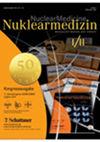Ausbildung in Nuklearmedizin und Zukunftsperspektiven.
IF 1
4区 医学
Q4 RADIOLOGY, NUCLEAR MEDICINE & MEDICAL IMAGING
引用次数: 0
Abstract
We read with the greatest interest the editorial by Carrio et al [1] and would like to express our full support for the idea of strengthening Nuclear Medicine as a clinical specialty. With the introduction and the emerging application of molecular imaging by PET/ CT and increasing development and application of different radionuclides in the treatment of various oncological entities, Nuclear Medicine has become an indispensable part of oncological management in many tumor patients [2]. The radionuclide therapy of neuroendocrine tumors, bone metastases, recurrent disease in thyroid cancer, and prostate cancer are some examples of established theranostics in our specialty. This requires, however, thorough basic knowledge of various tumors and of other oncological therapy modalities, as well as risk assessment and management of possible side effects. Prostate cancer is the third most common cancer in the USA [3]. Later on this year 2021, we are eagerly looking forward for the publication of the phase 3 VISION trial [4]. Patients with metastatic prostate cancer with PSMA positive scans were randomized in a 2:1 ratio to receive either 177Lu-PSMA-617 plus best supportive/best standard of care or to receive best supportive/best standard of care only. Primary end points of this study are overall survival and progression free survival based on radiology results. In case of a positive outcome this will tremendously boost therapy numbers in nuclear medicine centers and will require additional well trained nuclear medicine physicians and nuclear medicine technicians in the near future. Recent studies have reported the potential involvement of nuclear medicine in the management of patients affected by COVID-19 [5, 6]. On the other side, the COVID-19 pandemic also affected medical staff in some clinical departments in Europe. Therefore, we decided to provide assistance to other departments in our hospital with our staff (S.M.). The young residents and young specialists perform night guard in the pulmonary disease department and in the emergency department. Assistance in the oncology department will also be considered in the future. The physicians from Nuclear Medicine are assigned as residents and can contact senior physicians in the department in case of any uncertainties. This fruitful collaboration will also continue in the future. With this kind of cooperation, clinical needs for probably less common nuclear medicine investigations can also be identified earlier and appropriate adaptations, especially local ones, can be made. In the past, we have continued to offer investigations in our portfolio, which were no longer relevant in clinical routine use, such as radionuclide ventriculography; on the other hand, we have lost investigations in some centers, that could be used even longer, such as renal 99mTc-DMSA scan or quantitative lymphography of the extremities, or therapy of bone metastases with 153Sm. These regional losses were in part due to a lack of knowledge among clinical partners regarding the potential of nuclear medicine service. In addition, it should be noted that we hardly appear in the curriculum of medical studies for practical training of medical students in many countries. Therefore, neither students nor even young physicians have the opportunity to come into practical contact with nuclear medicine during their studies or in clinical practice, leading to an underuse of valid and clinically useful nuclear medicine procedures. In some countries, nuclear medicine departments no longer provide outpatient care for patients with thyroid diseases, which are now managed by endocrinologists. Moreover, the recently introduced oncological therapies, like Radium-223 [7] or 177Lu-DOTATOC [8] therapies are carried out in some centers by radiation therapists. These developments are partly due to the fact that available human resources in nuclear medicine departments have been committed in recent years mainly to PET-CT diagnostics, where there has been a huge increase in demand. Editorial核医科和对未来的希望。
本文章由计算机程序翻译,如有差异,请以英文原文为准。
求助全文
约1分钟内获得全文
求助全文
来源期刊
CiteScore
1.70
自引率
13.30%
发文量
267
审稿时长
>12 weeks
期刊介绍:
Als Standes- und Fachorgan (Organ von Deutscher Gesellschaft für Nuklearmedizin (DGN), Österreichischer Gesellschaft für Nuklearmedizin und Molekulare Bildgebung (ÖGN), Schweizerischer Gesellschaft für Nuklearmedizin (SGNM, SSNM)) von hohem wissenschaftlichen Anspruch befasst sich die CME-zertifizierte Nuklearmedizin/ NuclearMedicine mit Diagnostik und Therapie in der Nuklearmedizin und dem Strahlenschutz: Originalien, Übersichtsarbeiten, Referate und Kongressberichte stellen aktuelle Themen der Diagnose und Therapie dar.
Ausführliche Berichte aus den DGN-Arbeitskreisen, Nachrichten aus Forschung und Industrie sowie Beschreibungen innovativer technischer Geräte, Einrichtungen und Systeme runden das Konzept ab.
Die Abstracts der Jahrestagungen dreier europäischer Fachgesellschaften sind Bestandteil der Kongressausgaben.
Nuklearmedizin erscheint regelmäßig mit sechs Ausgaben pro Jahr und richtet sich vor allem an Nuklearmediziner, Radiologen, Strahlentherapeuten, Medizinphysiker und Radiopharmazeuten.

 求助内容:
求助内容: 应助结果提醒方式:
应助结果提醒方式:


